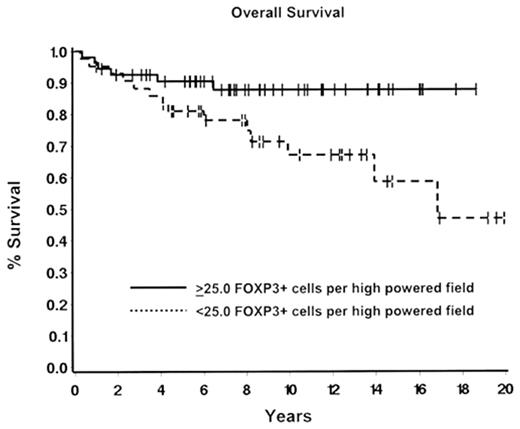Abstract
Background: Regulatory T-cells (Tregs), a CD4+, CD25+, FOXP3+ subset, appear to modulate the tumor microenvironment in lymphoma. Using FOXP3 expression as a marker of Tregs, single series have suggested that higher numbers of tumor infiltrating FOXP3+ cells are associated with improved survival in both follicular lymphoma and classical Hodgkin lymphoma (cHL). However, neither of these findings has been confirmed by separate studies and, in fact, contradictory data exists. We sought to evaluate potential correlations between the number of FOXP3+ cells in the tumor microenvironment and patient outcome.
Methods: 98 previously untreated cHL patients, biopsied and treated with curative intent at the Cleveland Clinic, were studied. FOXP3 was assessed by immunohistochemistry (Abcam) and quantitated as the number of positive cells per high power field (hpf), averaged over 5 fields. Histology was evaluated and medical records were reviewed for clinical features (including gender, age, stage, B symptoms, bulk, number of sites and IPS), lymphoma progression and death.
Results: The mean number of FOXP3+ cells (±standard deviation) was 41.7 ± 33.9 cells/hpf, and the median number was 36.4 cells/hpf (range 0–152.0 cells/hpf). Higher numbers of FOXP3+ T-cells were associated with age<45 (P=.02), stage I–II (P=.01), and IPS≤2 (P=.06) [Wilcoxon rank sum test]. 28 of the 98 patients (29%) have progressed and/or died and 20 (20%) have died. The estimated 5-year failure free survival (FFS) and overall survival (OS) are 76%±4% and 86%±4%, respectively. 70 patients remain alive with no evidence of disease at a median follow-up of 8.6 years (range 0.9–19.9 years). Recursive partitioning demonstrated an optimal cutoff of 25 FOXP3+ cells/hpf for analysis of outcome. Overall, 43 patients (44%) had a mean of <25.0 FOXP3+ cells/hpf and 55 (56%) had 25.0 or more. In univariate analysis, higher numbers of FOXP3+ T-cells in the tumor microenvironment were associated with better FFS; estimated 5-year FFS was 91% ± 4% for patients with >25.0 FOXP3+ cells/hpf compared to 81% ± 6% for patients with <25.0 (P=.05, generalized Wilcoxon test). There was also a trend towards improved OS (P=.10). In multivariate analysis, the number of FOXP3+ T-cells remained an independent predictor, even after adjusting for age, stage, and IPS ( P<.05). Kaplan-Meier curves for FFS and OS stratified by FOXP3+ “status” are shown in Figures 1 and 2.
Conclusion: FOXP3+ T cells are a favorable prognostic marker in cHL and reflect the importance of the immune response thus providing rationale for the use of immunomodulatory therapies in these patients.
Failure Free Survival
Overall Survival
Disclosure: No relevant conflicts of interest to declare.
Author notes
Corresponding author



